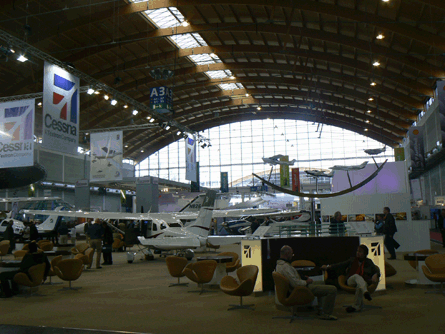Aero Friedrichshafen – Europe’s largest general aviation show – threw open its doors from 2-5 April to a community reeling from the global financial meltdown and battling one of the worst economic recessions in
history.
But despite the fiscal gloom, the mood at the show – located on the German shore of Lake Constance – was defiant. Exhibitor numbers were up and visitors flocked to the event in greater numbers than ever.
The show “surpassed expectations”, says its organiser, and Aero project manager Thomas Grunewald adds: “With 625 exhibitors – 12% more than at the last show in 2007 – and a 3% hike in visitors to more than 46,400, we don’t have the impression that the recession had any influence on this show and we hope Aero 2009 gave a positive signal for the global GA industry.”
Humble Beginnings
The exhibitor and visitor figures and the nature of Aero 2009 are a far cry from the show’s humble beginnings more than two decades ago. “The change has been huge,” says Grunewald. The first Aero consisted mainly of gliders and light aircraft, as well as some model aircraft, he says.
“The largest step in the development of the show was the move to the new grounds adjacent to the airport of Friedrichshafen. Aero’s spectrum is now huge – from parachutes to ultralight aircraft to sports aircraft to business jets.”
 |
|---|
© Kate Sarsfield/Flight International |
Aero has successfully drawn most GA manufacturers and vendors away from the traditional European aviation venues – notably the Berlin, Farnborough and Paris air shows – and the hubris felt by the show organiser is manifested in its decision to transform Aero from a biannual to an annual event from this year.
This decision is supported by the industry as niche regional shows become a vital business magnet for attracting dedicated buyers. “Over 60% of our exhibitors said they will support the annual cycle of Aero,” says Grunewald. “It’s not just another show – it’s Europe’s most important GA trade show. We believe that the global GA industry needs a speaking tube and a platform to be heard. By having an annual Aero, the global GA industry will have the possibility to discuss and to solve their problems and to fight threatening restrictions.”
Hot topics for discussion this year included European airport and airspace access, new pilot licensing proposals and the introduction of new environmentally led technologies such as engines and fuels.
Manufacturers across the aviation spectrum were in full swing during the four-day event. Embraer – exhibiting for the second time with its super-midsize Legacy 600 – says Aero’s success is largely down to the diversity of the show and its ability to market itself successfully to Europe’s owner-flyer community. Peter Kaiblinger, Embraer’s sales director for Europe, Middle East and Africa, says that although the economic climate is tough, there is still a great deal of interest in new aircraft and Europe represents a hugely significant market for manufacturers.
This view is supported by show newcomer Hawker Beechcraft, which displayed its Premier I and Hawker 750 business jets and King Air twin B200 twin
turboprop. “Europe is a key market and [niche] regional air shows like Aero have become an important way of attracting
regional customers,” says the manufacturer.
Cessna displayed its largest-ever product line-up, covering a range of piston singles – including the Corvalis 400TT, which made its show debut hot on the heels of its European approval. Cessna also brought its Caravan single-engined turboprop and Citation business jets, including the CJ3, XLS+ and another Aero debutant, the midsize Sovereign.
“The show was a conspicuous success,” says the airframer. “We were very pleased with the volume of visitors, particularly in the first three days. Our impression was that it was far busier than when we last participated two years ago.”
Light aircraft manufacturers Cirrus and Diamond displayed their full line-up – including the first Austro AE300-powered DA40, DA42 and DA50 piston singles – while Daher-Socata showed off its latest TBM 850 single-engined turboprop for the first time.
Aero organisers have worked to broaden the show’s appeal and to expand the visitor and exhibitor tallies. Grunewald stresses: “We strive to enhance Aero as the global platform for the presentation of new products in all segments of GA.”
This year saw the introduction of the E-Flight-Expo and helicopter exhibition – two individual hangars dedicated to alternative propulsion concepts and rotorcraft, respectively. A separate exhibit dedicated to the used aircraft market was also created.
Delayed Vision
Outside the exhibition halls, Cirrus announced a delay in its new aircraft development timetable while it awaits signs of global economic recovery. Certification of the SF50 Vision – formerly the SJ50 Vision – has been pushed back from late 2010 to 2012.
The Duluth, Minnesota-based general aviation aircraft manufacturer also said development of its SRS light sport aircraft “is under review” and it expects to decide on the two-seat aircraft’s future within a month.
The administrator for insolvent German aircraft engine manufacturer Thielert Aircraft Engines is to form a separate company dedicated to global sales and marketing of the Centurion diesel engine and spare parts.
The administrator also said it is “not in a hurry” to sell the beleaguered Thielert, which became insolvent a year ago
Source: Flight International























